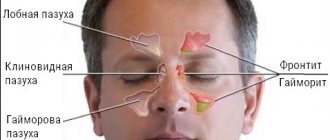Catarrhal sinusitis is an inflammation of the maxillary sinus, which is accompanied by the formation of mucous or serous exudate.
Source: myterapevt.com
The maxillary sinuses are connected to the nasal cavity by the maxillary cleft. When irritants act in the sinuses, excessive production of colorless mucus occurs, the mucous membrane swells, the excretory ducts are blocked, the outflow of secretory discharge is hampered, and it accumulates in the maxillary cavities of the nose. Favorable conditions are created for the development and reproduction of pathogenic microflora. The inflammatory process can develop on one side or spread on both sides of the nose to the infraorbital areas. With weakened immunity, the inflammatory process becomes chronic.
Severe complications are rare, occurring in approximately 1 in 10,000 cases of acute sinusitis.
In the catarrhal form of sinusitis, the clinical picture of the disease shows no signs of bacterial infection. Several types of exudate are formed: mucous, serous and serous-hemorrhagic.
The disease has no restrictions on age and gender, but catarrhal sinusitis is most often diagnosed in children.
Causes of catarrhal sinusitis
The development of the inflammatory process is more likely in the autumn-winter and winter-spring periods, when immunity is reduced due to frequent respiratory diseases.
Sinusitis occurs as a result of processes that are accompanied by impaired drainage of sinus contents and swelling of the nasal mucosa:
- complicated course of viral infections (influenza, parainfluenza, adenoviruses, etc.);
- improper treatment of chronic and vasomotor rhinitis;
- allergic reactions;
- weakened immune system;
- injuries of bones or soft tissues of the maxillary region;
- the presence of cysts and polyps in the maxillary sinuses;
- curvature of the nasal septum (narrowness of the nasal passages);
- infectious diseases (measles, scarlet fever);
- dental pathologies;
- the presence of foci of chronic infection of the nasal and oral cavity (chronic pharyngitis, adenoid growths).
Forms
Catarrhal sinusitis can occur in acute and chronic forms. The duration of the acute period is 2–4 weeks. Without treatment, the acute form of the disease can become chronic.
The chronic form of catarrhal sinusitis is divided into the following types:
- edematous;
- hypertrophic;
- mixed.
Forms of catarrhal sinusitis according to the localization of inflammation:
- unilateral sinusitis (left- or right-sided);
- bilateral.
Unilateral sinusitis differs from bilateral sinusitis in the breadth of inflammation of the paranasal sinuses and the severity of the course.
In the development of sinusitis, the determining factor is a violation of the functional state of the mucous membrane of the maxillary sinuses.
According to the route of infection of the maxillary sinus, there are:
- rhinogenic sinusitis – the source of infection is the nasal cavity;
- hematogenous - the causative agent of infection enters the sinus through the blood;
- odontogenic – a consequence of inflammatory processes in the teeth of the upper jaw.
Source: medicsina-online.ru
Treatment prognosis and possible complications
The prognosis for catarrhal sinusitis is positive. If you follow all the doctor’s recommendations, your condition will improve quickly.
If treated incorrectly or incorrectly, catarrhal sinusitis turns into a purulent form. In addition, complications may develop in the form of the following diseases:
- acute otitis;
- meningitis;
- sepsis.
In the absence of a full therapeutic course, the consequences of the disease can be unpredictable and very unfavorable. Just the fact that the catarrhal form of sinusitis develops into a purulent form should convince the patient to consult an otolaryngologist. This is especially important when it comes to young children, who are much more susceptible to this type of illness.
Sinusitis can lead to inflammation of the tissue located in the periocular area. As a result, edema develops
Features of catarrhal sinusitis in children
In newborn children, the maxillary sinus is not formed; it is a gap that does not contain air. By the age of four, the maxillary sinus takes on the appearance of a cavity, its formation is completed, and in the future it only grows. Therefore, the occurrence of sinusitis in a child is considered possible no earlier than three to four years.
Catarrhal sinusitis is observed more often in children than in adults, which is due to the structural features of the maxillary sinus and nasal passages. In children, they are small and narrow, this impedes the outflow of exudate and leads to the accumulation of secretions in the nasal cavity and paranasal sinuses.
Symptoms of catarrhal sinusitis
At the initial stage, the inflammatory process is identical in clinical picture to a respiratory disease.
After a few days, symptoms of catarrhal sinusitis appear:
- aching, throbbing pain in the maxillary sinus, which intensifies when bending forward;
- headache, aggravated by palpation, bending and turning;
- increased body temperature;
- light yellow liquid discharge from the nose;
- general signs of intoxication of the body (fatigue, apathy, nausea);
- impaired nasal breathing on the affected side;
- cough that bothers you at night or at rest.
A change in the shade of the exudate to yellow-green indicates that the inflammatory process has turned purulent. With bilateral catarrhal sinusitis, the clinical picture is supplemented by the following signs:
- profuse lacrimation when tilting the head;
- swelling of the lower or upper eyelids;
- bilateral respiratory failure, the patient is forced to breathe through the mouth.
In the catarrhal form of sinusitis, the clinical picture of the disease shows no signs of bacterial infection.
Chronic sinusitis does not manifest itself in any way during periods of remission, and during exacerbations it causes symptoms similar to acute ones, but they are less pronounced and last longer.
Symptoms
General symptoms of sinusitis manifest themselves as the following:
- headache (pain may intensify when tilting the head forward);
- pain in the forehead and eye sockets;
- difficulty breathing through the nose;
- purulent discharge from the nose.
With catarrhal sinusitis, symptoms of general intoxication of the body may be expressed. However, they are not clearly visible. This is weakness, general fatigue, apathy, loss of appetite, decreased performance, increased body temperature.
With untreated diseases of the nasopharynx, excessive accumulation of mucus occurs. This creates favorable conditions for bacteria, which lead to swelling of the mucous membrane. In case of hypothermia, the same thing happens.
Catarrhal sinusitis is a deeper inflammatory process than ordinary sinusitis. This type of sinusitis is dangerous because inflammation can spread to organs such as the eyes and brain, since they are located very close to the sinuses. As a result, complications arise: phlegmon, orbital periostitis, meningitis, blindness.
All sinuses, which are located near the nose, have outlets that connect the sinus and the nasal area. When swelling of the mucous membrane occurs, these openings close. Pus cannot come out in this case. The inflammatory process is activated due to mucus accumulating in the maxillary sinus.
To fight inflammation, the body begins to work effectively. What is he doing? It begins a large production of leukocytes, they help fight infection and guard our immunity. If there are not very many leukocytes, and the culprit of the disease (bacteria) itself is aggressive, then the inflammation develops into a purulent form. In this case, sinusitis ends not only with swelling, but also with inflammation of the sinuses. With this turn of events, the doctor makes a diagnosis of acute catarrhal sinusitis.
An interesting fact is that acute catarrhal sinusitis is very rarely diagnosed in children under 6 years of age. This is due to the fact that the maxillary sinuses are not yet fully developed. Whereas in children over 6 years of age, acute catarrhal sinusitis occurs more often. This disease itself is usually classified as an acute stage.
With catarrhal sinusitis, the mucous membrane of the maxillary sinus becomes inflamed, as we wrote above. This inflammation can sometimes involve the periosteum and bone (acute catarrhal sinusitis). Therefore, if your runny nose does not go away for a long time or any symptoms of sinusitis appear, immediately make an appointment with a doctor.
Diagnostics
In the development of sinusitis, the determining factor is a violation of the functional state of the mucous membrane of the maxillary sinuses. Therefore, the basis for diagnosing catarrhal sinusitis are methods that allow one to assess the degree of damage.
The examination of patients with catarrhal sinusitis includes:
- ENT examination;
- general blood test;
- sinusoscopy;
- therapeutic and diagnostic puncture of the maxillary sinus;
- X-ray examination.
Treatment of catarrhal sinusitis
Complex conservative drug therapy is carried out, which consists of the use of the following groups of drugs:
- antiseptic nasal solutions;
- vasoconstrictor, oil drops;
- sea salt solutions, saline solution, antiseptic solutions for rinsing the nasal passages;
- physiotherapeutic procedures [UHF, quartz, ultraviolet irradiation, electrophoresis, laser heating, inhalation treatment, nasal lavage using the Proetz (cuckoo) method of moving fluids];
- antihistamines;
- anti-inflammatory drugs;
- antibiotics in the form of drops, inhalations and sprays for irrigation of the nasal mucosa;
- tablet forms of antibiotics from the group of cephalosporins, macrolides or penicillins.
Complex therapy allows you to eliminate swelling of the nasal mucosa, create conditions for the evacuation of inflammatory exudate from the sinuses, normalize breathing and stop inflammation.
As a rule, treatment of catarrhal sinusitis brings a positive effect within 7–10 days. The chronic form of catarrhal sinusitis requires longer therapy.
The occurrence of sinusitis in a child is considered possible no earlier than three to four years.
In the absence of a positive effect from drug therapy, if the catarrhal form becomes purulent, puncture of the maxillary sinus is indicated. During the procedure, the contents are evacuated through aspiration and the sinuses are washed with antiseptic solutions.
Source: gorlonos.com
In cases where puncture of the maxillary sinuses is ineffective or there are factors that constantly provoke the disease (injuries to the bones or soft tissues of the maxillary region, hypertrophy of the nasal turbinates), minimally invasive surgical treatment methods are used (balloon sinuplasty, laser correction, Caldwell-Luc surgery).
Treatment
Treatment of catarrhal sinusitis can be conservative or surgical. It all depends on the nature of the inflammation. He is being treated quite successfully. The main thing is to see a doctor in time. Otherwise, the disease becomes chronic, which is no longer so easy to cure. When visiting a doctor at the first symptoms of sinusitis, 90% of patients are cured. Incorrect treatment or an advanced form of the disease leads to bone death. In this case, the patient ends up on the surgical table.
With conservative treatment, the doctor prescribes, first of all, vasoconstrictor drops. The most popular drops in this segment are Naphthyzin. The use of drops relieves swelling of the sinus mucosa. A side effect of using such drugs is rapid addiction. The patient begins to use them more and more often and soon cannot do without them at all. People with diseases of the cardiovascular system should remember that vasoconstrictor drops can cause a rise in blood pressure.
In addition to drops, the doctor prescribes antihistamines. They are designed to relieve swelling. Among them, the most common are drugs such as diphenhydramine, suprastin, tavegil. Antibacterial drugs are used that have a wide spectrum of action. An integrated approach uses:
- Desensitization therapy.
- Probiotic preparations (Linex, Bion 3, Normoflorin).
- To soften the nasal mucosa (Comozitum, Pinosol).
- Restoration of the nasal mucosa (Sinupret).
- Antiseptic therapy (Miramistin, Octenisept).
- Physiotherapy (laser therapy sessions, ultraviolet irradiation, ultrasound irrigation of the nasal cavity).
If drug treatment for catarrhal sinusitis is ineffective, a puncture of the maxillary sinuses is prescribed. This surgical procedure is performed in a specialized department of the otolaryngologist's office. The purpose of this surgery is to remove pus from the sinus.
In terms of its effectiveness, nasal rinsing comes first in the treatment of sinusitis. Before this procedure, you should consult your doctor. Rinsing the nose at home is usually done with a saline solution. Pharmacies also sell special preparations and rinsing devices. The most popular of them are Aqua Maris and Dolphin.
The use of folk remedies will speed up the healing process. But before using them, consult an ENT doctor.










